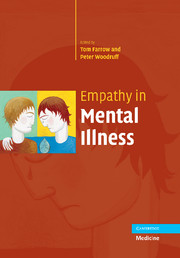Book contents
- Frontmatter
- Contents
- Foreword
- List of contributors
- Part I ‘Dysempathy’ in psychiatric samples
- Part II Empathy and related concepts in health
- 9 Neonatal antecedents for empathy
- 10 The evolutionary neurobiology, emergence and facilitation of empathy
- 11 Naturally occurring variability in state empathy
- 12 Neuroimaging of empathy
- 13 The neurophysiology of empathy
- 14 The cognitive neuropsychology of empathy
- 15 The genetics of empathy and its disorders
- 16 Empathogenic agents: their use, abuse, mechanism of action and addiction potential
- 17 Existential empathy: the intimacy of self and other
- 18 Empathizing and systemizing in males, females and autism: a test of the neural competition theory
- 19 Motivational-affective processing and the neural foundations of empathy
- 20 Face processing and empathy
- Part III Empathy models, regulation and measurement of empathy
- Index
12 - Neuroimaging of empathy
from Part II - Empathy and related concepts in health
Published online by Cambridge University Press: 17 August 2009
- Frontmatter
- Contents
- Foreword
- List of contributors
- Part I ‘Dysempathy’ in psychiatric samples
- Part II Empathy and related concepts in health
- 9 Neonatal antecedents for empathy
- 10 The evolutionary neurobiology, emergence and facilitation of empathy
- 11 Naturally occurring variability in state empathy
- 12 Neuroimaging of empathy
- 13 The neurophysiology of empathy
- 14 The cognitive neuropsychology of empathy
- 15 The genetics of empathy and its disorders
- 16 Empathogenic agents: their use, abuse, mechanism of action and addiction potential
- 17 Existential empathy: the intimacy of self and other
- 18 Empathizing and systemizing in males, females and autism: a test of the neural competition theory
- 19 Motivational-affective processing and the neural foundations of empathy
- 20 Face processing and empathy
- Part III Empathy models, regulation and measurement of empathy
- Index
Summary
Introduction
Empathy, the ability or process ‘to identify with and understand another's situation, feelings and motives’ would initially appear an unlikely candidate for neuroimaging research. Being aware of, and interpreting, other's behaviour on an emotional level is likely to be recently evolved and hence a ‘high-level’ cognitive process. Such complex brain processes are generally considered as unlikely to have a dedicated brain region serving them, or to be easy to isolate for examination.
This chapter will describe how empathy has been dissected into a set of component cognitive processes, how brain imaging researchers have designed experiments to examine various combinations of these components, and what these finding may tell us about empathy's neurophysiological basis.
A neuroimaging primer
It may be useful to begin by summarizing the field of neuroimaging, and highlighting which aspects may be of relevance. Structural neuroimaging concerns the physical size and integrity of brain tissue, and in as much as there may be a relationship between size and function, if we could identify brain regions which were part of an empathy system or circuit, then investigating their size or integrity may be informative (presuming that we can objectively measure subjects’ behavioural empathic levels). Functional neuroimaging utilizes surrogate markers (normally regional blood flow) to infer which parts of the brain are ‘active’ whilst a specific task or mental process is undertaken.
- Type
- Chapter
- Information
- Empathy in Mental Illness , pp. 201 - 216Publisher: Cambridge University PressPrint publication year: 2007



